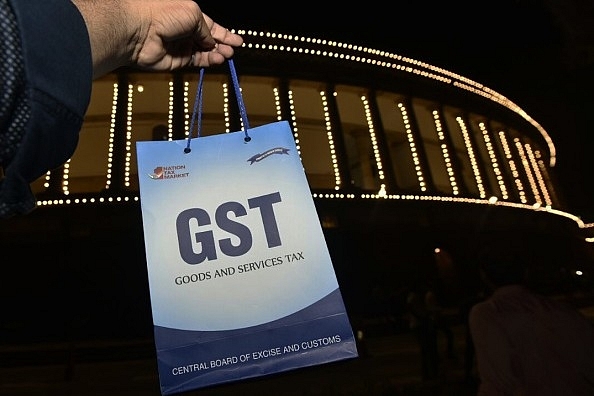Economy
Why Furore Over Retention Of GST Cess In Consolidated Fund Of India Is a Manufactured Controversy
- The key issue is of handling the surplus reserves in the Compensation Cess Fund since public money cannot be kept idle.

GST is the new unified tax regime in India. (photo by Arun Sharma/Hindustan Times via Getty Images)
There has been a recent controversy surrounding the CAG report which has observed that the central government transferred funds from the GST Compensation Fund to the Consolidated Fund of India.
It is important to understand some of these issues as many are trying to manufacture a controversy where there is not any.
For starters, the GST compensation fund is the revenue that is generated from the compensation cess that is levied under the GST regime. This cess is levied with the objective of compensating the states for any shortfall in the revenue due to the implementation of the GST reforms.
Recall that Centre had guaranteed states a compensation for up to 5 years assuming 14 per cent of growth rates in taxes for various state governments while building the consensus on GST.
The compensation cess fund is therefore an account where the revenue generated from compensation cess is kept and used for compensating the states that have witnessed a shortfall in tax revenues.
In this particular instance, after paying all compensation, there was still surplus reserves left in the compensation cess fund. This was subsequently transferred by the government to the main fund and this is what has been objected to by the CAG.
It is, however, also important to note that the government has in fact transferred the amount back to the relevant fund and it has cleared all GST compensation related dues till FY2019-20. Therefore, to suggest that there has been misappropriation of funds is an unfair assertion by those that are making this charge. As a matter of fact, the total amount of compensation released for the year 2019-20 was Rs 1,65,302 crores while the amount of cess collected was Rs 95,444 crores. The rest of it was transferred by the centre to the compensation cess fund.
The CAG has, however, rightly noted that such transfers should ideally not take place given the present legal framework.
But the issue of how to handle surplus in the fund is also a concern that needs to be considered as having the funds in the Compensation Cess Fund would not be an optimal utilisation of taxes.
This may not be a problem going forward as the borrowings due to GST shortfalls during the early months of the year will be financed through the amount raised by the compensation cess. However, should there still be a surplus, there needs to be a mechanism for transfer of funds to various governments – and how to recover it subsequently – during times of revenue shortfalls.
This is important to ensure that the tax revenue being collected is subsequently used and put back into the system in the form of government spending in some form or the other. Hopefully, the GST council will look into this issue and come up with a framework for such situations over the coming few months.
The other issue is of the exercise of transfer to Consolidated Fund resulting in understatement of deficits. It is important to recognise that since government had to invariably transfer the money back to the Compensation Fund, it will be reflected as a higher expenditure in the year the money is transferred back to the fund. Thus, the exercise of transferring money to the Consolidated Fund makes little impact on the medium-term fiscal deficits or debt-to-GDP ratio. Moreover, the amount as a percentage of GDP is too small to really have an impact on the outlook due to our deficits or public debt levels.
It is important to ignore the political rhetoric and address the key issue of handling surplus reserves in Compensation Cess Fund as we cannot allow for public funds to be kept idle – especially since both Central and state governments are often struggling to finance productive investments.
One hopes that the GST Council would create such a mechanism that will allow for the funds to be shared and deployed as and when needed – while they could be replenished in the event of tax shortfalls till 2022.
A potential suggestion could be to use the surplus funds to finance human capital investments after 2022 while gradually removing all non-tobacco and non-automobile items out of the categories of goods that attract compensation cess.
Introducing ElectionsHQ + 50 Ground Reports Project
The 2024 elections might seem easy to guess, but there are some important questions that shouldn't be missed.
Do freebies still sway voters? Do people prioritise infrastructure when voting? How will Punjab vote?
The answers to these questions provide great insights into where we, as a country, are headed in the years to come.
Swarajya is starting a project with an aim to do 50 solid ground stories and a smart commentary service on WhatsApp, a one-of-a-kind. We'd love your support during this election season.
Click below to contribute.
Latest